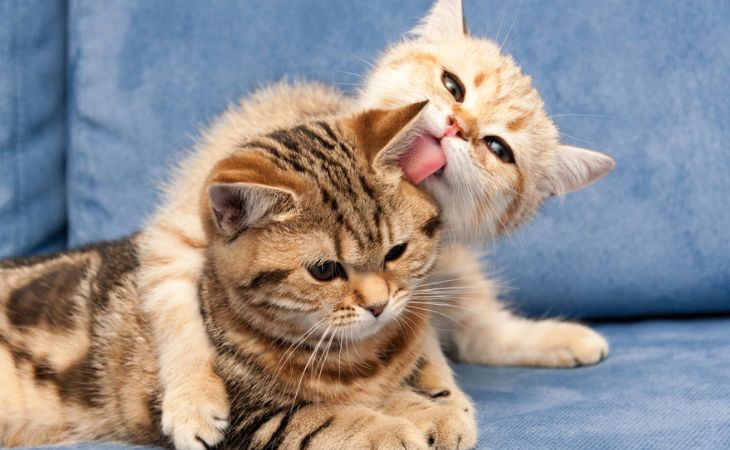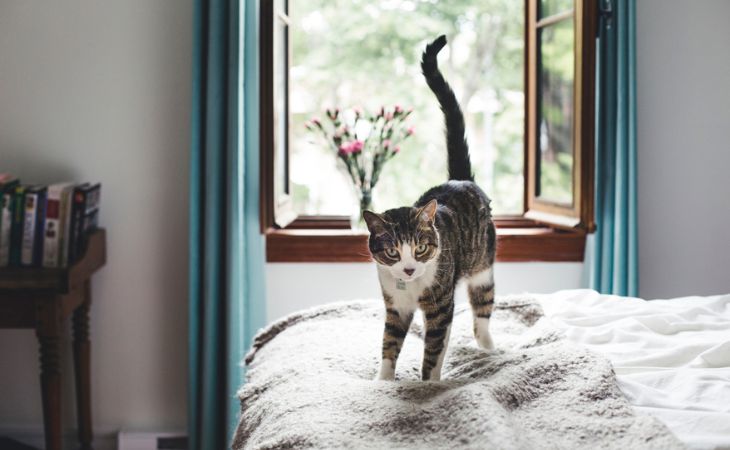When you decide to adopt a cat, you might spend some time thinking about which sex is right for you. You might consider the behavioral advantages of each one. For some, female cats are more affectionate and less inclined to run away during their heat cycle. Male cats, on the other hand, as well as being prone to cat fights, love marking the house with their urine. To help you choose the sex that corresponds to your life and personality, Letsgetpet is highlighting the main differences between male and female cats.
Behavioral characteristics of male cats
When male cats reach the age of sexual maturity, they start to apprehend the world around them in a different way. They are now capable of venturing out miles and miles to seduce a female cat. They also mark their territory inside and outside of the house by leaving pheromones contained in their urine. Considered to be true adventurers, male cats are ready and willing to take risks to defend their territory or to spread it out even further (even at the point of causing fights with other cats).
Mortal accidents caused by cars also happen frequently with male cats, which according to statistics seems to prove that the average lifespan of males is reduced compared to females. In addition, when you have more than one cat that doesn’t go out, you can have brawls, because their territorial behavior gets worse during heat.
Behavioral characteristics of female cats
Female cats are often described as easy to live with or homebodies. However, they can also be as independent as male cats and only come back home to eat and sleep. Females are, in general, more gentle, but they can also be more active and demanding that male cats (whether you let them go outside or not). When they go out, they can take as many risks as male cats. Therefore, it’s possible for female cats to get run over by a car, get lost or fight for things related to territory and return home with wounds.
The heat cycle is very difficult for female cats, especially if you keep them inside the house. Between stress and excitement, they will employ several strategies to attract male cats:
- constant meowing
- urine marking
- scratching the couch, sofas, and the furniture
Female cats are capable of having four litters per year. If your female is born at the beginning or end of the year, their heat cycle can start even before they reach 6 months.
Male and female cats: what are their similarities regarding character?
Contrary to what one might think, there are no major differences between male and female cats when it comes to character. Among their common traits are the fact that they are both curious, independent, and attached to their territory and customs. According to many testimonials, male cats are more present than female cats, who are more proud and solitary. A female can, however, sulk once you return home from being away for several days.
When it comes to male kittens, they are known for being more mischievous and dynamic, while females are more shy and reserved. In reality, this can be the case for all kittens. Within a litter, it is also possible to notice differences in the temperaments regardless of the sex. Because of this, a fine observation of their attitudes is more interesting than concentrating on these criteria.

Spaying and neutering: responsible actions
Offering a longer life and better health to your pet, spaying and neutering allows you to lower the number of unplanned litters. A couple of non-sterilized cats can in just a few years, give birth to thousands of kittens. To avoid kittens getting abandoned or left out on their own, think about spaying or neutering them as soon as you become the pet parent of a cat.
What are the benefits of spaying and neutering?
Male cats can be neutered at any moment of their life. However, it is preferable to plan the procedure the earliest possible. While the ideal age for neutering is around 6 to 8 months, some vets proceed with this operation earlier (between 2 and 4 months). This practice is rather controversial because the potential effects on the health of the animal are still unknown.
After spaying or neutering, you will notice the lessening of certain unpleasant behaviors. Females become more gentle and homebodies. Since the operation prevents the appearance of heat, female cats will no longer meow to attract males. Spaying and neutering reduces considerably the risks of mammary tumors and infections of the uterus.
In males, neutering reduces the risks of fights and, therefore, getting bitten or scratched. We can also note the lessening of marking their territory with sprays of urine.
Both males and females spend less time away from the house and don’t travel as far from the house, which reduces the risks of mortal accidents. Spaying and neutering are two excellent ways to limit the transmission of diseases like cat AIDS.
What does spaying and neutering consist of?
Both of the procedures are done under general anesthetic. In order to spay female cats, the vet need to remove the ovaries. They can, however, opt for the removal of the uterus. The advantage of this procedure is that it’s possible to do this a few weeks after they give birth. In male cats, neutering consists of removing the testicles via the bursa. They are, therefore, incapable of producing spermatozoa or testosterone.
While the procedure is rather quick (between 15 and 30 minutes depending on the sex), the day of, the cat needs to fast, because the operation requires opening the abdominal cavity. Depending on the vet, the cat can go back home the evening of. An antibiotic treatment must still be put in place for several days after the procedure.
After the operation, different points need to be surveilled. Spaying and neutering raises the probability of urinary stones. You can, however, reduce the risk by giving them good quality food (by alternating between wet and dry food). As a cat parent, you should also keep an eye on the weight of your feline. This is because the procedure can lead to a loss of the reflex of fullness. To avoid this, change your cat’s food to a food for spayed and neutered cats or lower their food intake according to the recommendations of your vet.
You might also find this article interesting: Cats and their fear of the vet
How much does the spaying or neutering of a cat cost?
There is no set fee for spaying or neutering a cat. In France, it can cost between 110 and 200 euros for a female and between 60 to 180 euros for a male. Vet clinic prices can take into account or not the pre- and post-operative care. To be sure, do not hesitate to contact your vet in order to asks them what the price covers.
You can also find ways to lower the price of the spay and neuter procedure. If you live in an urban area, you can go to the countryside, because the price should be a bit lower there. Do not hesitate to contact animal welfare organizations. They should be able to recommend partner clinics that do this procedure for a reduced price. In France, you can also consider going to a vet school, because they propose interesting prices for this type of operation.

